Images of War
In the West, war cartoons and etchings have a long history, dating back to before the days of medieval woodcuts. Goya's Disasters of War, for instance, was preceded by the terrifying scenes of Jacques Callot's (1592–1635) famous Miseries of War (1633). Later, during World War I, the Dutchman Louis Raemaekers (1869–1956) conveyed the outrages of that conflict through the use of cartoons, and Käthe Kollwitz, as we have seen, produced remarkable portraits of the anguish of wartime misery and hunger by means of various graphic arts techniques.
Chinese war cartoons have a shorter history. They began to appear sporadically in the late 1910s and early 1920s, at a time when conflicts between China and foreign powers were intensifying. Shen Bochen's "Qingdao, Shandong province" (1919) (fig. 5), for example, depicts Japan's imperialist intentions in China: while a skull with a rising-sun emblem on its forehead is ready to gobble up Qingdao City and Shandong province, the Chinese people fight gallantly to save their land. The cartoon reflects foreign aggression on the one hand and the soaring nationalist fervor in China on the other. Indeed, it accurately expressed the feelings of the young May Fourth generation, who, on that memorable Sunday of 4 May 1919, took their anger to the streets of Beijing to protest foreign encroachment on China's sovereignty and the ineptness of the Beijing warlord government. Predictably, Chinese war cartoons did not appear in profusion until the formal conflict between China and Japan erupted in mid-1937, but then they started streaming forth, forming a powerful visual narrative of modern Chinese history.
Chinese wartime cartoons relied heavily on directness and common imagery to achieve their effect. Like David Low's devastating exposés
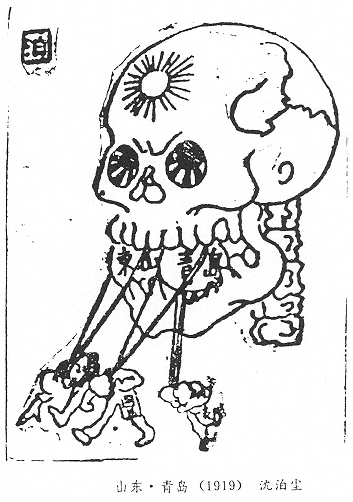
Fig. 5.
Shen Bochen, "Qingdao, Shandong province." From Bi Keguan and
Huang Yuanlin, Zhongguo manhua shi (Beijing: Wenhua yishu
chubanshe, 1986), pl. 66.
of fascism, Chinese wartime cartoons focused not on the abstract inhumanity of war, but on the physical concreteness of the crisis. In both cases, the images were solid and the lines sure, leaving no doubt about who the villain was. But there were distinct differences between Western and Chinese cartoons as well: while the former occasionally delivered their message with a light touch, Chinese cartoons were deadly serious. They also tended to be simpler in design and less fluent in artistry; the novelty of the craft in China and the exigency of the
time precluded sophistication. As a result, one saw few bold symbols like the American cartoonist Daniel Fitzpatrick's (1891–1969) tumbling swastika,[16] nor did one encounter the exquisitely delineated details of the Polish artist Arthur Szyk's (1894–1951) anti-Nazi drawings.[17] What they lacked in artistic subtlety and refinement, however, they more than made up for in their robust vitality and compelling images.
The power of images in art has been much studied.[18] The image—or what it represents—can easily arouse anger, sympathy, desire, or myriad other emotions. Very often cartoon images communicate ideas that are too abstruse for verbal expression. But for images to be effective, they must be grounded in concreteness: they must have their source in real life. Unlike fine art, which tends to have a relatively complex and layered motivation, political cartoons by definition are simplistic and very often combative. They rely on popular sources for their appeal, and their context is often overlaid with rich emotive signs; this gives them a strong sense of familiarity and directness. Like their Western counterparts, Chinese cartoonists were concerned primarily with political and psychological expression. "In comparison with literature, which uses abstract language to express ideas," observed Feng Zikai, "the propaganda effect of the cartoon is definitely faster and more powerful."[19]
To have the maximum impact, many Chinese cartoonists argued that they had to carefully compose appropriate images and present them creatively and systematically, with participation from both artists and audiences. But could cartoons, a modern urban art, command universal appeal? Or should different types of cartoons be addressed to different people? Liao Bingxiong warned that illiterate peasants did not necessarily understand cartoons. Formerly an elementary school teacher, Liao was particularly concerned with how to communicate with the less educated. Although a member of the Cartoon Propaganda Corps, Liao criticized his fellow artists for failing to present simple enough images to the masses. "Their works were not popularized enough," he said.[20]
Since individual pieces with complicated artistic designs could be confusing, "picture storytelling" might help. But what if no one was around to explain the cartoon? Like Hong Shen with spoken drama, Liao suggested that images were most compelling if presented in a serial story format. As such, they were coherent, featuring sequences of simple, realistic pictures and facts interspersed among the stories. A Cantonese who came under the influence of storytelling and other folk
arts in his early years, Liao believed that cartoonists could use the mode of traditional storytelling to establish a rapport with the people, and then allow the images to work their magic. Such a combination of a traditional performing art and modern drawing was one of many ingenious tactics advanced during the war. Liao's highly popular wartime cartoon serials, including "The War of Resistance Is Bound to Be a Victory," certainly bore this fact out.[21]
Although the cartoon changed during the war in terms of technique and imagery, its themes and messages remained remarkably the same. In general, Japan was depicted as an aggressive beast, a culture turned barbaric and committing atrocities on its neighbor from whom it once borrowed invaluable cultural and intellectual treasures. The frequent repetition of certain motifs suggested not a rigidity of approach but the desire to create a lasting impression on viewers. Japan's thrust into China, for example, might be portrayed as a venomous snake forcing its way through the Great Wall (fig. 6). But it was the Nanjing Massacre in December 1937 that truly shocked the world. The enemy's behavior in this notorious incident was partly captured by Li Keran's (1907–1989) "Killing Contest" (fig. 7), based on an actual incident in which two Japanese soldiers engaged in a "friendly Contest" to cut off the heads of 150 Chinese.
Among thousands of cartoons produced during the war, several important themes emerge. First is the forced separation of mother and child. In a cartoon entitled "Feeding on Blood" (fig. 8), which bears an unmistakable Groszian imprint in technique, Cai Ruohong depicts a scene after Japanese planes have bombed a Chinese city: a baby sucking at his dead mother's breast, her body, still bleeding, lying amid the rubble. A bundle wrapped in cloth just beside the woman's body indicates that she is a refugee, her attempt to flee the war having proved futile. The child is cradled in her left arm, suggesting the poor mother's desperate effort to protect her baby before her death. Meanwhile the infant, innocent and incapable of knowing the terrible fate that has befallen his mother, sucks hungrily for nourishment. In its dramatic portrayal of the moment when death abruptly severs the intimate bond between mother and child, leaving the infant unprotected and helpless, Cai's cartoon, based on an actual Japanese air raid in Shanghai in the fall of 1937, is one of the most shocking images of Japanese wartime violence. It was widely reprinted and left an indelible impression on all those who saw it.[22]
In an equally forceful cartoon, Feng Zikai presents a similar but even more graphic scene: a mother meeting a horrible death while nursing her baby (fig. 9). Feng Zikai accompanied this frightening
scene, which occurred in 1937 in Jiaxing, Zhejiang province, with a moving ci poem:
In this aerial raid,
On whom do the bombs drop?
A baby is sucking at its mother's breast,
But the loving mother's head has suddenly been severed.
Blood and milk flow together.[23]
In this cartoon, images and words blend to register a most appalling sight. Unlike the Western practice, where the commentary is printed either below a drawing in caption form or coming out of the mouths of the subjects in balloons, Feng Zikai's method here was to use a conventional Chinese form: poetry. A silent poem describes the incident with great poignancy and yet speaks loudly of the artist's pain and anger. Although such a juxtaposition of visual representations and poetry is familiar in Chinese art, Feng's technique—the cartoon—is new and his messages contemporary.
The separation of mother and child was, however, but a small part of the larger human tragedy that was unfolding. There were other incidents: reducing villages to ashes, ravishing women (in Hu Kao's "Japanese Soldiers' Bestiality," fig. 10), committing random massacres, and torturing prisoners—"rape, obscenity, looting, and slaughter," as Lu Zhixiang summed it up.[24] For Chinese cartoonists surveying the Japanese destruction, indiscriminate killings were perhaps the most condemnable. Scenes of enemy planes dropping bombs on innocent people were abundant in Chinese cartoons (as in Zhang Leping's "Basic Training for the Enemy Air Force").[25] In "Bombing" (fig. 11), Feng Zikai paints a picture of impending doom: a school for the blind and the mute is about to be hit by bombs. No one inside the school will be spared; but more appalling is the fact that these handicapped students have no way of knowing about the imminent catastrophe.
With their villages devastated, loved ones killed, and property lost, those who narrowly escaped death managed to grab a few belongings and flee the yoke of Japanese occupation. The result was endless treks of refugees—another perennial theme in wartime cartoons. Ye Qianyu, for example, tells the story of one family's ordeal in "Living for Vengeance" (fig. 12).
Japanese cruelties were regarded as so gruesome that they could be compared only to the acts of beasts. Cai Ruohong's "Eastern Pirate's Specialty" depicts Japan as a monstrous ape mutilating innocent Chinese people and then devouring them (fig. 13). Reptiles were another common negative image (see fig. 6), for in Chinese folklore the
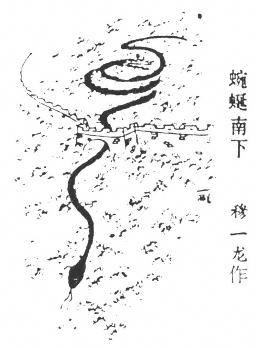
Fig. 6.
Mu Yilong, "A Viper Wriggles Southward." From Bi
Keguan and Huang Yuanlin, Zhongguo manhua
shi, pl. 183.
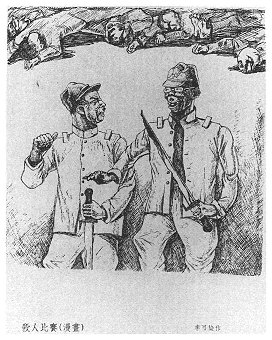
Fig. 7.
Li Keran, "Killing Contest." From Wenyi
zhendi 2.6 (1 January 1939): n.p.
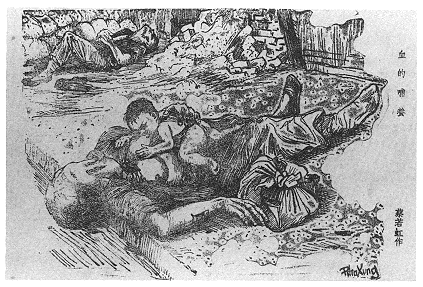
Fig. 8.
Cai Ruohong, "Feeding on Blood." From Fenghuo 1 (5 September 1937): n.p.
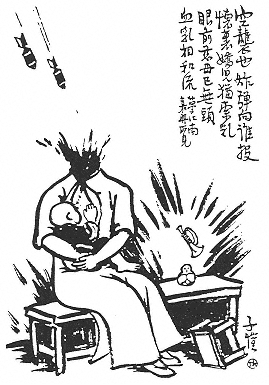
Fig. 9.
Feng Zikai: A mother's head severed. From China
Weekly Review 88.6 (8 April 1939): 177.
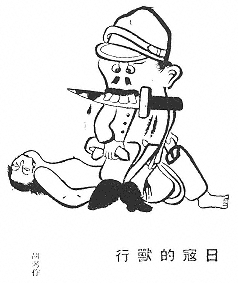
Fig. 10.
Hu Kao, "Japanese Soldiers' Bestiality." From
QGXJ, p. 85.
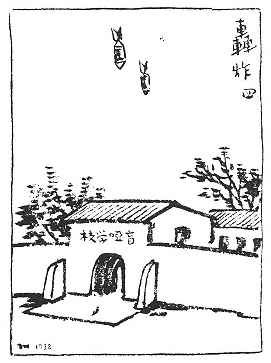
Fig. 11.
Feng Zikai, "Bombing (Scene No. 4)." This
cartoon depicts bombs descending on a school
for the blind and the mute. From Feng,
Zhanshi xiang (N.p.: Kaiming shudian,
1945), p. 12.
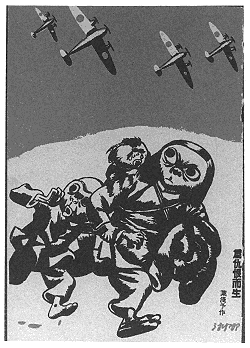
Fig. 12.
Ye Qianyu, "Living for Vengeance." From W. H.
Auden and Christopher Isherwood, Journey to a
War (New York: Random House, 1939)
(reproduced by permission of the publisher).
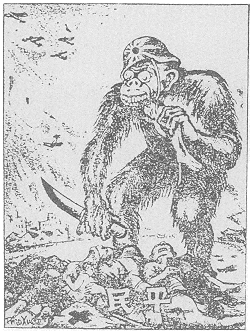
Fig. 13.
Cai Ruohong, "Eastern Pirate's Specialty." The
bodies on the ground are labeled
"people." From QGXJ, p. 84.
snake is regarded as "clever but wicked and treacherous"[26] —an adequate description of the invading Japanese. Cartoonists also portrayed Japanese soldiers as pigs and dogs, animals that behaved in a most deplorable way.[27] The use of bestial imagery, of course, is common in wartime propaganda.[28] In Charles Press's words, as a form of psychological warfare it is "meant to be cruel and to hurt…. The hate shines through, uncontrolled and slightly insane."[29] By dehumanizing the enemy, propagandists could justify the armed resistance as a crusade against barbarism and evil. By the same token, the Chinese were themselves depicted as lions or tigers, symbols of courage, pride, and steadfastness. The imposing presence of the majestic big cats expressed the country's resolve to resist and to win, thus stimulating the flagging spirit of the Chinese people.[30] Such an approach set up an opposition of subhuman and human, evil and good, in which the viewer was clearly aligned with the latter.
The root cause of the war lay in Japanese militarism, and it was at that militarism that Chinese cartoonists directed their heaviest attacks. Wartime cartoons showed Japan as a nation stymied by internal conflict and mired in economic and political crises. But the major threat to Japan's welfare, as the cartoonists correctly suggested, came from the military. In general, they assumed that aggression occurred when internal checks were absent and the military was allowed to overwhelm the civilian government. Japan faced just such a dilemma. The country, wartime cartoons tell us, was the victim of unbridled military power. Its emperor had become powerless, and the high officers of the army and navy, like a colossal monster, manipulated Prime Minister Konoe Fumimaro.[31]
Japan was also portrayed as a nation that showed little respect for international law. Zhang Ding, for example, pictures a Japanese soldier disemboweling a woman with his bayonet (fig. 14) to satirize Japan's unilateral abrogation in 1938 of the Nine-Power Pact (signed sixteen years earlier at the Washington Conference). In addition to their routine defiance of the international community, the Japanese had more ominous designs abroad. The military leaders presented themselves deceptively as men of peace, proffering an olive branch to make "cooperation" between China and Japan palatable, or promoting cordial understanding between Japan and its Asian neighbors with its "Greater East Asia Co-Prosperity Sphere." This was a huge ruse, cartoonists warned, nothing but a dangerous trap. Japan, Gao Longsheng (1903–1977) cautioned, was like a two-headed man: one half
held out a gun while the other half toasted with a glass of champagne; his ultimate intention, however, was clear for all to see (fig. 15).
But Japan was not the only country with malicious designs. As another cartoon by Gao Longsheng showed, Japan together with Hitler formed an awful alliance aimed at conquering the world (fig. 16). The image of a mask, a familiar motif in Western and Soviet art,[32] was now adopted by Chinese cartoonists. Zhang E's "A Nazi Soldier," for example, depicts a trooper with a swastika on his helmet removing a mask labeled "Peace" from his aggressive face. The German invasion plan, Zhang cautioned, included annexing Austria and attacking the Soviet Union.[33] The emphasis was thus not on Japan's invasion of China alone, but on the danger of the spread of fascism throughout the world and its threat to civilization and peace. Like Low and Fitzpatrick, Chinese cartoonists warned that Japanese fascism was no local phenomenon; it was part of an international conspiracy that threatened the very survival of the human race.
Chinese artists also made careful attempts to distinguish between the Japanese people and their aggressive military leaders. The assumption was that war was created by the machinations of ambitious warlords, who dreamed of foreign aggrandizement and military glory. Like the Chinese under enemy occupation, the Japanese people at home faced coercion. Their leaders extorted money from them and compelled them to submit to harsh labor so that the militarists could maintain their war machine abroad, continuing their dream of conquering China. Zhang Ding, in a cartoon entitled "Unbearable" (fig. 17), portrayed this exploitation, which was pushing the nation to the brink of social and economic ruin, as being like loading a heavy cannon on the back of an emaciated donkey. Of course, the idea that the Japanese army did not enjoy popular support at home overlooked a strong right-wing, militaristic sentiment in that country. Nevertheless, the portrayal of a powerful military was correct: in the late 1930s it indeed controlled the government and every facet of society.
The threat to China's stability and survival as a nation came not only from outside, but also from within. The killing and plundering by Japanese troops required accomplices in China. Hence the War of Resistance was more than just a defense against outsiders; it was also a civil war against China's internal enemies, the hanjian (traitors). By clearly differentiating between patriots and hanjian, the intellectuals in a sense affirmed their own morality. Attacking hanjian thus became a ritual of self-justification, an act that reassured upright citizens about
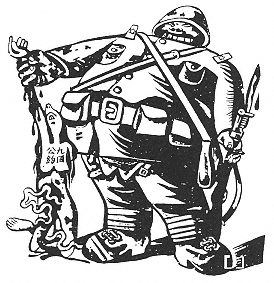
Fig. 14.
Zhang Ding: The destruction of the Nine-Power
Treaty. The characters on the woman read,
"Nine-Power Treaty." From JWMH 10
(5 November 1937): 3.
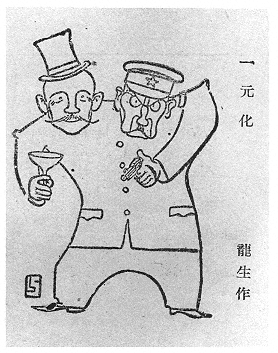
Fig. 15.
Longsheng (Gao Longsheng), "United." From
Yue bao 1.3 (15 March 1937): 474.
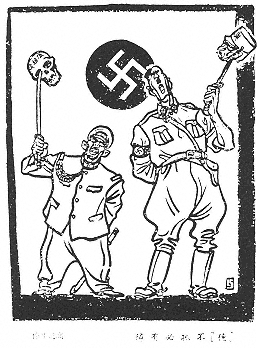
Fig. 16.
Gao Longsheng, "'De' bu gu, bi you lin." The
original quote from Analects (IV, 25) means
"Virtue never dwells in solitude, it will always
attract neighbors." Here, however, the term de
stands for "Germany" (Deguo) rather than
the original "virtue" (de). The cartoon depicts
Hitler holding a head labeled "Austria." The
characters on the skull held by a Japanese
general read, "Puppet organization." From
QGXJ, p. 61.
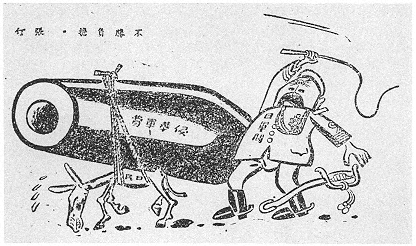
Fig. 17.
Zhang Ding, "Unbearable." The cartoon is labeled "military expenses for
China invasion"; the donkey is the "Japanese people," and the man
is identified as "Japanese warlord." From QGXJ, p. 39.
the correctness of their behavior and conferred honor upon those who embraced the same view.[34] Like the Yang Wencong type in Chinese wartime dramas, the hanjian is ubiquitous in Chinese cartoons, diminutive, cringing, outrageously shameless, and despicable in his obsequiousness. In the eyes of Liao Bingxiong, an early follower of Covarrubias who later became known for his distinctively original and thought-provoking works, a traitor is willing to do anything for his foreign masters (fig. 18). Liao used dramatic geometric lines and distortion to portray a most ignominious act: a master, with a glass of champagne before him and his muscular right hand under his chin, glows with delight and pride as his lackey, kowtowing at his feet, offers up his most precious belonging—his head.
When Wang Jingwei became head of a puppet government in Nanjing in March 1940, he instantly emerged as the embodiment of base servility. As the news of his submission to the Japanese spread, cartoonists wasted no time in unleashing a barrage of scathing attacks on China's Number One Traitor. To them, the capitulation of Wang, the former disciple of Dr. Sun Yat-sen (Sun Yixian, 1866–1925) and an erstwhile revolutionary leader, was repugnant and intolerable. In the eyes of Te Wei, the setting up of a new government under Japanese aegis was nothing more than a farce played to its fullest extent.[35] And indeed, Wang's regime was precisely as Feng Zikai's cartoons depicted it: "a monkey show," an ignominious puppet performance that cost untold lives.[36] Still, Chinese collaborators were not confined to political figures like Wang Jingwei. As Gao Longsheng and Lu Zhixiang pointed out, a collaborator could be any one of any number of people—warlords, frustrated politicians, spineless men of letters, coldblooded youths, or hatchet men.[37] The image of the treacherous, furtive traitor was so prevalent in Chinese wartime cartoons that it served as a constant reminder to the people that they must always be on the alert: the evil ones could destroy them if they allowed their defenses to slip.
According to Chinese wartime cartoons, however, the greatest danger to the nation's survival was neither the ferocity of the enemy and their military superiority, nor the havoc caused by traitors, but a weak will to resist. War could easily spread despair and create disorientation among the people. To win the war, and ultimately to save the nation, the Chinese people had to be transformed from unconcerned onlookers to active participants.
In Ye Qianyu's "Abandon the Civilian Life, Join the Army" (fig. 19), the famous cartoon character Mr. Wang (see fig. 2) has assumed a
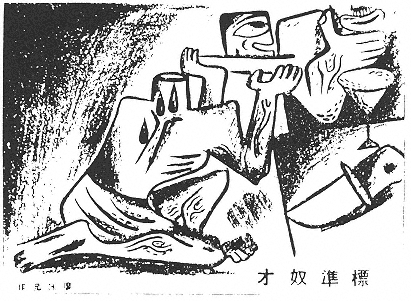
Fig. 18.
Liao Bingxiong, "A Typical Lackey." From Bi Keguan and Huang Yuanlin,
Zhongguo manhua shi, pl. 184.
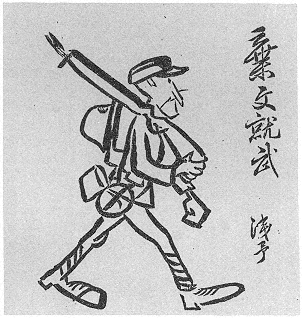
Fig. 19.
Ye Qianyu, "Abandon the Civilian Life, Join the Army."
From Xin dongxiang 2.10 (30 June 1939): 751.
new identity. No longer a petty bourgeois indulging in a decadent life in a corrupt city like Shanghai, Mr. Wang has donned a military uniform. He is wearing a helmet, carrying a gun, and marching to the battlefront. The transformation of Mr. Wang from a typical middleclass Philistine to a resolute patriotic soldier worked as a compelling call to arms, underlining the urgent need for every citizen's participation in the struggle against the Japanese. The ultimate strength of the resistance lay at the grass-roots level: a successful war against Japan could only be a people's war. The heroic struggle waged by common civilians against the invaders is vividly captured by Liang Baibo in "Let's Hand the Enemy an Even More Deadly Blow Following the Victory in Southern Shandong" (fig. 20). A man, filled with anger and standing upright like Hercules, is about to focus all his might on pounding a Japanese soldier with his mallet. The aggressor, defeated and fallen to the ground, shakily raises his crooked, blood-stained sword as he looks helplessly at impending doom. The gigantic stature of the hero contrasts dramatically with the diminutive villain. The outcome of the battle, as this cartoon clearly tells us, is decided not by the type of weapon used, but by the people's determination to fight. The first critical acts of resistance are therefore shown to be those of individuals, common men and women who dare to stand up and fight.
The people's power can be awesome, Lu Shaofei pointed out. In his "The Strength of the Armed People" (fig. 21), Lu depicts a Japanese soldier surrounded by raging peasants, who are determined to use every conceivable means to crush the invader. Again, the vivid contrast between the immense size of the Chinese resisters and the smallness of the intruder has a far greater impact on the audience than would subtle nuances. Such a device, of course, enjoys a long tradition in the West—consider James Gillray's famous series of cartoons about Napoleon, which ridiculed Bonaparte ("Little Boney") as a dwarf in military attire, or pieces by cartoonists such as Daniel Fitzpatrick during World War II. And as we have seen, it was also put to vigorous use by various Chinese artists. Part of the effectiveness of the device lies in its suggestion of Chinese superiority, spiritually if not militarily—though ironically, when the enemy was presented as the beastly aggressor, it was he who was huge and towering; only when the focus was on the valiant resistance of the Chinese people did he appear as diminutive and petrified.
In Lu Shaofei's piece, the sheer number of the Chinese people involved in the battle was shown to be a deciding factor in the final outcome. To defeat the enemy, the Chinese people must unite together.
And the unity of the will to resist, as Te Wei's cartoon indicates, is just like building an iron wall that will hold back the enemy's incursion (fig. 22). Besides symbolizing unity, the wall stood for something tangible: hard labor and war bonds. The contrast between the one (a lone Japanese soldier) and the many (a multitude of Chinese), along with the opposition of high (Chinese on top) and low (Japanese at the bottom), conveyed the same kind of optimism about the outcome of the war. The title with its familiar phrasing, "Mass will forms an impregnable wall" (zhong zhi cheng cheng), appealed directly to patriotic sentiment. To ignore the strength of the masses or to fail to mobilize them would be the gravest mistake that any government could make. If the masses were left unattended, as Zhang Ding's cartoon "The Abandoned and Unorganized Masses" cautioned, the country would face grave consequences: there would be no logistic support to soldiers at the front, hooligans and local tyrants would betray their country because of lack of internal constraint, and women and children would be molested and slaughtered by the enemy troops.[38] Zhang's piece served as a somber admonition to the government.
Women and intellectuals also figured prominently in wartime cartoons. Like Hua Mulan in spoken dramas, the women depicted in cartoons display not only beauty and charm, patience and care, but also valor and resolve, virtue and strength.[39] "I hope that every baby girl born will grow up like Hua Mulan," Feng Zikai said, thereby expressing his hope and admiration for the woman warrior (fig. 23).[40] But unlike Hua Mulan, who joined the army on behalf of her ailing father (thus not totally of her own will) and whose identity was concealed until the very end, the modern-day Hua Mulan went to the battlefront voluntarily and had the full support of both her family and her country. With the revival of the Hua Mulan image in cartoons, a familiar experience of the past was given a new visual interpretation and a new context.
Two women cartoonists were particularly well placed to capture the thoughts and sensibilities of women in wartime China. In her "Sharing Equal Responsibility" (fig. 24), for instance, Liang Baibo shows how women assumed a multitude of important roles during the war—as nurses, as suppliers of munitions and medical aid, as members of the "battlefront visiting teams," and as soldiers. Against the background of a huge national flag, the young women in the cartoon exhibit confidence and optimism: their gaze focused, their heads held high and expression animated, they display utmost determination. Like the female symbols of resistance in the spoken drama, the figures
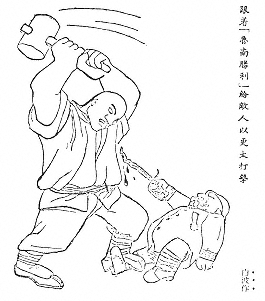
Fig. 20.
Baibo (Liang Baibo), "Let's Hand the Enemy
an Even More Deadly Blow Following the
Victory in Southern Shandong." Chinese
soldiers scored a victory against Japanese
troops in Taierzhuang, Shandong province, in
April 1938. From QGXJ, p. 26.
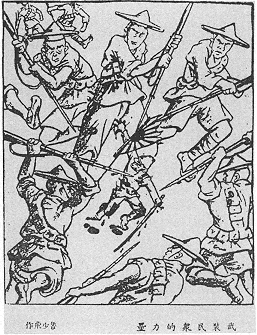
Fig. 21.
Lu Shaofei, "The Strength of the
Armed People." From QGXJ, p. 100.
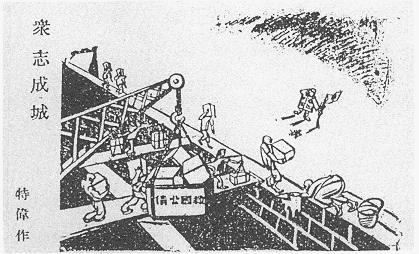
Fig. 22.
Te Wei, "Mass Will Forms an Impregnable Wall." The cargo is labeled
"war bonds." From JWMH 8 (25 October 1937): 3.
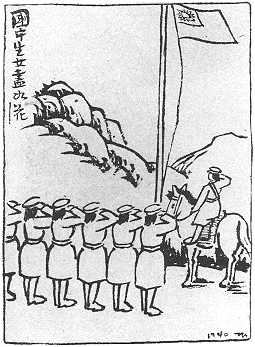
Fig. 23.
Feng Zikai, "I Hope That Every Baby Girl Born
Will Grow Up Like Hua Mulan." From Feng,
Zhanshi xiang, p. 5.
in Liang's piece remind us that in comparison to men, women can contribute just as much, if not more, to their country. Yu Feng's "Let the Gunfire of National Salvation Smash This Pair of Shackles," portraying a woman breaking off her handcuffs in a battle (fig. 25), is an even more forceful statement. The piece, though lacking in artistic refinement, nevertheless evoked a passionate response. To Chinese women, the War of Resistance may have meant more than just defeating the enemy; it also meant liberation from all kinds of suppression, including Confucianism, which relegated women to an inferior status. The title of the piece plays on this sentiment: it is a call to resist all oppression, be it foreign or domestic.
What about the role of intellectuals? More than any other citizens, cartoonists argued, Chinese intellectuals should assume a greater burden of responsibility in time of war. As guardians of moral rectitude and social truth, as well as the embodiment of knowledge and wisdom, they served as important role models for the common people. The catastrophe that had engulfed the nation demanded immediate action. Failure to take a stand was not just a sign of weakness; it was a disgrace and a moral crime. When the survival of a nation is at stake, neither passivity nor dispassionate inquiry should be tolerated. "Let's Change into New Uniform," Ye Qianyu urges, calling on his comrades to join the resistance movement (fig. 26).
Like their civilian countrymen, Chinese soldiers were portrayed as selfless and valorous. They were professional men who were ready to take up arms to defend their homeland. Chinese cartoons, however, featured no individual soldier heroes like Bill Mauldin's (1921-) "Willie and Joe"; neither did they carry the satirical and critical tone of Mauldin's pieces.[41] Mauldin prowled World War II foxholes to uncover a realistic, personal picture of war, his unshaven and sunkeneyed American GIs summing up the predicament of battle-weary infantryman. Chinese cartoonists, however, penned their soldiers in a more idealistic and abstract fashion—as heroic and resolute, always ready to lay their lives on the line. Zhang Ding's "Recover Lost Territory" (fig. 27) is a case in point. Depicted again in colossal size, the soldier stands upright, holds his head high, grasps his gun and sword firmly, and, exuding an air of self-confidence, calls on his countrymen to join hands to recover lost territory. The Great Wall reemerges not only as the ultimate line of defense but also the starting point for recovering land from the enemy. Besides bravery, the idea of self-sacrifice, of dying a heroic death, was also frequently invoked.[42]
Images in that vein, though, represented not the grim reality of the battlefield, but the imaginations and wishful thinking of patriotic artists. It is therefore not surprising that much of wartime art was exhortatory.
Nevertheless, to present a convincing picture, images must be grounded in real-life events. The Battle of Taierzhuang (April 1938) provided a rare opportunity to do so in a positive manner. That battle was the first major victory registered by Chinese forces since the outbreak of the war. After repeated defeats and humiliation at the hands of a better-equipped Japanese army, the victory could not have come at a better time. It was more than a morale booster: it shattered once and for all the myth of the invincibility of the Japanese war machine. Predictably, the victory quickly found its way into pictures and images. Te Wei, for example, recorded the euphoria in his "Warriors at Taierzhuang" (fig. 28): a soldier, a grenade in his left hand and a bloodstained sword in his right, charges fearlessly toward the enemy's encampment, followed by his comrades.
Without downplaying the importance of conventional warfare, Chinese cartoonists also placed increasing emphasis on guerrilla warfare, especially after the second alliance between the GMD and the CCP was announced. Perfected by Mao Zedong, guerrilla warfare is characterized by surprise and deception, together with extreme mobility of troops. Liao Bingxiong's "Guerrillas"[43] and Ding Cong's "How Come I Still Haven't Met an Eighth Route Army Soldier?" (fig. 29) reflected this strategy well. The increasing recognition that cartoonists accorded guerrilla warfare reflects the approval that Chinese artists in general felt for Mao's unique military approach.[44] Indeed, the Communist tactics won the praise even of Western cartoonists, including David Low.[45]
The second alliance between the GMD and the CCP, in 1937 in the wake of the Xi'an Incident (December 1936), was hailed by most Chinese as an epoch-making event. It was, in fact, a crucial step toward reunifying China after decades of chaos and incessant civil war. Pushed by the political exigencies of the time, warring factions resolved to set aside their differences and face their common foe. Continued partisan wrangling, both sides realized, would only paralyze the country further, presenting the enemy with an easy prey. Cai Ruohong's cartoon "A Sacred Handshake" (fig. 30) perhaps best expressed the sentiments of the time: a strong desire to end the bitter civil war and to see a grand alliance between the GMD and the CCP—
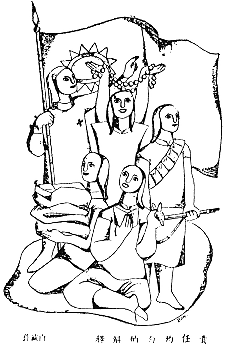
Fig. 24.
Baibo (Liang Baibo), "Sharing Equal
Responsibility." From QGXJ, p. 8.
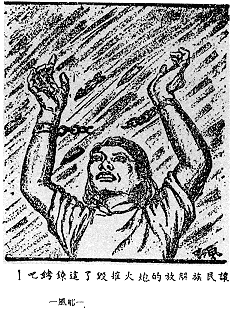
Fig. 25.
Yu Feng, "Let the Gunfire of National
Salvation Smash This Pair of Shackles.
" From QGXJ, p. 103.
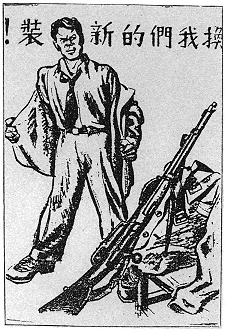
Fig. 26.
Ye Qianyu, "Let's Change into New
Uniform." From T'ien Hsia Monthly 7.4
(November 1938): n.p.
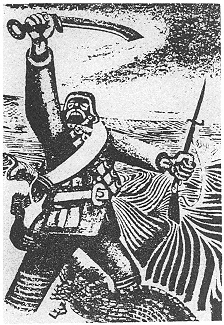
Fig. 27.
Zhang Ding, "Recover Lost Territory."
From JWMH 3 (30 September 1937): 3.
and against the invaders—finally materialize. The alliance, however, turned out to be short-lived, and the two parties soon renewed their old animosity.
To instill an optimistic spirit, Chinese cartoonists presented a bright future: the War of Resistance might be protracted and bitter, but if the Chinese people could join together as a single unit, they would triumph in the end. Such a notion was repeatedly cultivated. Cai Ruohong's famous cartoon "Surges of National Resistance," for instance, depicts the whole nation under arms: like roaring waves, the Chinese people will drown the invaders in the sea (fig. 31). Japan's penetration into China's interior, this cartoon also shows, is like sinking deeper and deeper into a quagmire. It is doomed to failure. The China quagmire became one of the most popular images used in Chinese wartime cartoons.[46]
In sum, wartime cartoon images were nationalistic, emotional, and idealistic. Using visual rhetoric, they portrayed a besieged nation fighting not merely for survival, but for justice and peace. The majority of cartoons were strong and spirited political statements, resting on the simple assumption that the current conflict was caused by Japan's unbridled imperialism—a theme designed to rekindle the bitter memories of repeated foreign encroachment on China in the past century. To repel the invaders and to rebuild China, nothing short of total unity was required. Unity was thus the cartoonists' battle cry.
For many cartoonists, the decision to participate in the resistance movement was an act of patriotism and a realization of their role as responsible citizens. But patriotism did not mean blind loyalty to the government. In fact, as the war progressed, cartoonists became increasingly critical of the GMD.
By the early 1940s, the excitement and high morale of the early war years had eroded as the economy was ravaged by inflation and the political climate became more oppressive. Initial support for the Nationalists had given way to alienation and disillusion. Cartoons critical of the government began to appear, mostly of an allegorical sort. For example, such images as "A Rich Man's Air-Raid Shelter" in Ye Qianyu's series "Wartime Chongqing" (1941), behind their humorous facades, condemned the extreme inequality that existed in the wartime capital.[47] And Ding Cong's (Xiao Ding) "The Social Phenomenon" (1944) painted a gloomy picture of society plagued by social ills and economic dislocation.[48] In Ding's piece, Guomindang society was a world populated by ruthless officials, profiteers, and penniless intellectuals. Liao Bingxiong's "A Professor's Meal" (1945) spoke
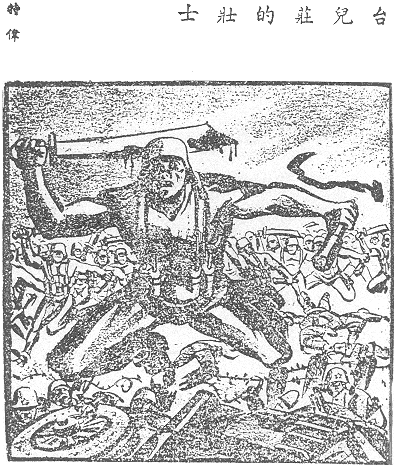
Fig. 28.
Te Wei, "Warriors at Taierzhuang." From QGXJ, p. 19.
further of the intellectuals' ordeal: dressed in tatters and with empty bowls, an enervated teacher and his family are eating his Western book to fill their empty stomachs.[49] The scene was an embarrassment to the teacher, but more important, it was a disgrace to the Nationalist government, for it pointed out its inability to feed the Chinese people. Zhang Guangyu's colorful series "Journey to the West" ("Xiyou manji," 1945) made similar charges; here we find the pilgrimage of Tripitaka and his three disciples from the Ming novel being used as a backdrop,[50] though instead of monsters and deities, the pilgrims now encounter bribery and government demoralization on their journey to
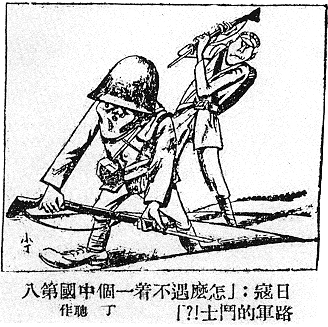
Fig. 29.
Ding Cong: Japanese invader says, "How come I still haven't met
an Eighth Route Army soldier?" From JWMH 8 (25
October 1937): 4.
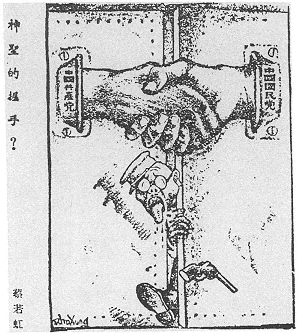
Fig. 30.
Cai Ruohong, "A Sacred Handshake." The characters on
the left read, "Chinese Communist Party," and on the
right, "Chinese Nationalist Party." (According to the
artist, the question mark after the title "Sacred
Handshake" was a misprint; letter to the author, 26
July 1992.) From QGXJ, p. 17.
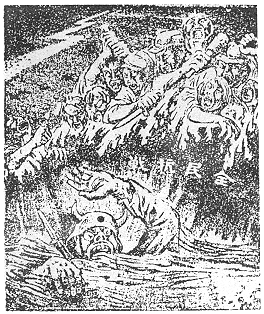
Fig. 31.
Cai Ruohong, "Surges of National Resistance."
The characters in the middle read, "United
resistance." From JWMH 1
(20 September 1937): 1.
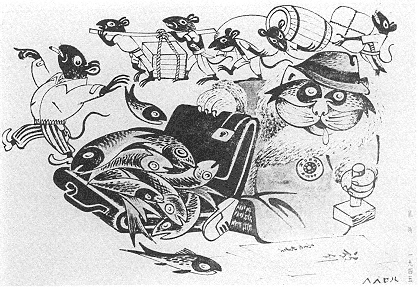
Fig. 32.
Liao Bingxiong, "Mouse Bribery." The characters on the document read,
"Passed." From Liao, Bingxiong manhua (Guangzhou: Lingnan meishu
chubanshe, 1984), n.p.
the Buddha's paradise. Cartoon criticism intensified during the civil war period. Liao Bingxiong's "The Cat Kingdom" ("Maoguo chunqiu," 1945–1946), a devastating series on the dictatorial rule and corruption of the Guomindang, set the tone for what would follow in the ensuing years. In "Mouse Bribery," Liao painted a cat bearing the GMD emblem being plied lavishly with fish; in return he allows the mice's smuggling activities to continue unrestrained (fig. 32).[51] This visual assault no doubt further undermined the public support for the government.